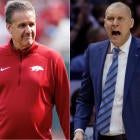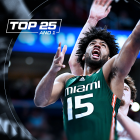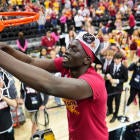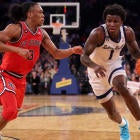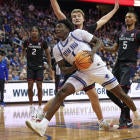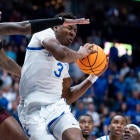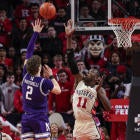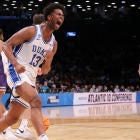There are two links between college basketball and the NBA: the NBA Draft and college players' eligibility for that draft.
Few things have been more consistently/furiously debated in basketball over the past decade like the one-and-done stipulation. While the NCAA was erroneously targeted in the primitive years of the rule, it's always been an NBA-mandated commandment, something put in place and agreed upon by the NBA and the NBA Players Association. The league and its players want to keep 18-year-olds out of the pros, and it's going to stay that way for the foreseeable future.
Anyone bent on the fact that kids with all-world basketball talent coming out of high school can't capitalize immediately on that talent within weeks -- even days -- of their high school graduation, well you have the helpless right to remain annoyed.
On Wednesday, the NBA's new collective bargaining agreement (CBA) -- which always deals with the age minimum, among many things -- was rubber-stamped. Here's the news: college hoops will remain a one-and-done sport. (And that's not a bad thing; more on that below.)
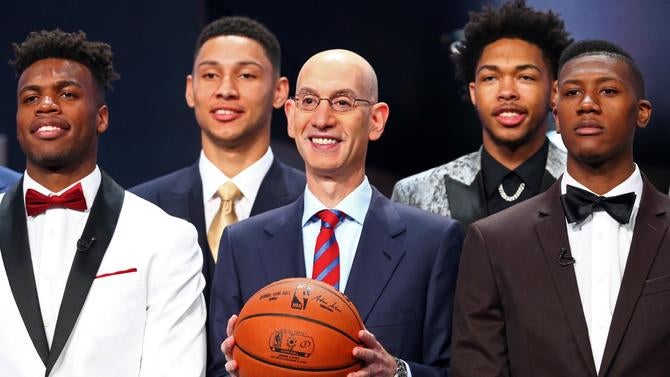
The CBA is for seven years, with an option to step out and renegotiate after six. Here's the weird part: the age minimum stipulation is specifically exempt from that timeline. The one-and-done rule could be gone 10 months from now ... or never? From NBA.com's David Aldridge:
The current "one and done" rule allowing college players to declare for the NBA Draft once they've completed a year of college or have been out of high school for a year, will remain in place. The league has sought to increase the age limit to 20; the union has resisted that and would prefer no limit or a rule similar to that of Major League Baseball. MLB allows high school players to declare for its draft but prohibits players who opt to attend college from declaring until after their junior year in college. The union sought a so-called "zero and two" compromise that would allow high schoolers in the NBA Draft but keep college players from declaring until after their sophomore season in college.
Here's the real: There is no perfect solution. You can't have a two-and-through rule, because that eliminates the inevitable. Every year we see freshmen boost their draft stock in a few months and turn into first-round picks. Taking that option off the table is just as unfair -- and even more illogical -- than the current mandate.
The NBA is not going back to the way it was. The free-for-all days are done, and it'll be at least another generation before that option is even legitimately on the table again. High school seniors are not going to be allowed to jump right to the league. The NBA would love do what the NFL does and keep players out until they're three years removed from their high school graduation. That way you have the best chance at bringing in the most experienced players, and on the whole the league is older/wiser/more knowledgeable.
That's never going to happen, though.
The intriguing aspect here is how the new deal allows for some growth and continued perspective, and perhaps we see a scenario in two or three years from now wherein the CBA affixes a new provision for entering the draft. Either you leave right out of high school or you commit to play in college and have to spend at least two years there before you can put your name in the draft pool.
But that's not an improvement. If anything, it's a scare tactic, and it's likely to push a number of would-be college stars to the pros too early, wherein plenty will invariably fail. Dumping a bunch of 18-year-old prospects/projects to the D-League at a higher rate than what currently happens, well that's not better for the NBA and it's certainly not better for college basketball. If the day comes where the NBA and its Players Association ever agree to that, I'm confident it would almost certainly revert back to the current rule in subsequent CBA dealings thereafter.
The current setup isn't entirely fair -- see Ben Simmons last year, wherein he openly admitted he was using the college system because he had to -- but it is working out best for both sides. Does it make a farce of the college experience? Yes ... for about 10 players, if that, every season. You're talking about 0.2 percent of eligible players for the draft every year.
The practical takeaway is that the NBA's age minimum is only making a folly of the NCAA amateurism model for a handful of players each year. Much of this hubbub bubbles up in false outrage. Few people truly care that Simmons bailed on LSU the minute his season was done.
You needn't look any further for proof that the current arrangement works best for both sides than by glancing at college hoops right now, this season. The sport is boasting arguably its strongest crop of freshmen in the one-and-done era. Bluebloods (UCLA, Kentucky, Duke, Kansas) are thriving off the additions from Lonzo Ball, T.J. Leaf, De'Aaron Fox, Malik Monk, Jayson Tatum and Josh Jackson. You cannot argue this is bad for college hoops; it's vital to the sport's relevance and watchability prior to February. Most (all??) of those players I just mentioned would've gone right to the NBA had the age minimum not been in place. College hoops would've been fine, generally speaking, but it probably wouldn't be having a blueblood renaissance and it certainly wouldn't be better off.
The "fairest" way is to go back to how it was, to keep the NBA as an open market and allow 17- and 18-year-olds with elite talent to declare immediately. But the NBA doesn't want its scouts attending AAU tournaments and it doesn't want the league skewing that young. The NBA has the right to do what's best for its business, and if you look at the trends, the age minimum has catalyzed a positive effect for the league -- and done even more for college hoops in the process. It makes sense to keep the rule as is. It can never be perfect, but this is the best it can be.














